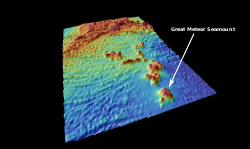Great Meteor Seamount
| Great Meteor Seamount | |
|---|---|

Great Meteor Seamount at the southern edge of the Atlantis-Meteor Seamount Complex
|
|
| Summit depth | 270 m (890 ft) |
| Height | 4,500 m (14,800 ft) |
| Summit area | 50x28 km² (1465 km²) |
| Location | |
| Location | North Atlantic Ocean, 1,000 km (620 mi) south of the Azores |
| Coordinates | 29°57′10.6″N 28°35′31.3″W / 29.952944°N 28.592028°WCoordinates: 29°57′10.6″N 28°35′31.3″W / 29.952944°N 28.592028°W |
| Geology | |
| Type | Guyot |
| Volcanic arc/chain | Seewarte Seamounts |
| History | |
| Discovery date | 1938 |
| Discovered by | Meteor |
The Great Meteor Seamount, also known as the Great Meteor Tablemount, is a large guyot located south of the Azores in the Atlantic Ocean. It is the New England hotspot's most recent eruptive center and is one of the most thoroughly investigated seamounts in the world. Rising up from a depth of almost 4,800 m (15,700 ft) to about 270 m (890 ft) below the surface of the Atlantic, Great Meteor has an area of 1,465 km2 (566 sq mi) and a summit plateau measuring 50 by 28 km (31 by 17 mi). On the southwest side it is flanked by the smaller Little Meteor Seamount and the still smaller Closs Seamount.
The German research vessel Meteor discovered the tablemount between 1925 and 1927. It was given the name Great Meteor Bank, a designation still used in the official GEBCO gazetteer.
The New England hotspot formed the White Mountains 124 to 100 million years ago when the North American continent was directly overhead. As the continent drifted to the west, the hotspot gradually moved offshore. On a southeasterly course, the hotspot formed Bear Seamount, the oldest in the chain, about 100 to 103 million years ago. Over the course of millions of years, it continued creating the rest of the seamounts, eventually culminating in the Nashville Seamount about 83 million years ago. As the Atlantic Ocean continued to spread, the hotspot eventually traveled further east, forming the Great Meteor Seamount where it is found today.Radiometric dating of basalt from the Great Meteor Seamount has given ages of about 11 and 16 million years old, with the bulk of the seamount possibly having formed about 22 million years ago.
...
Wikipedia
